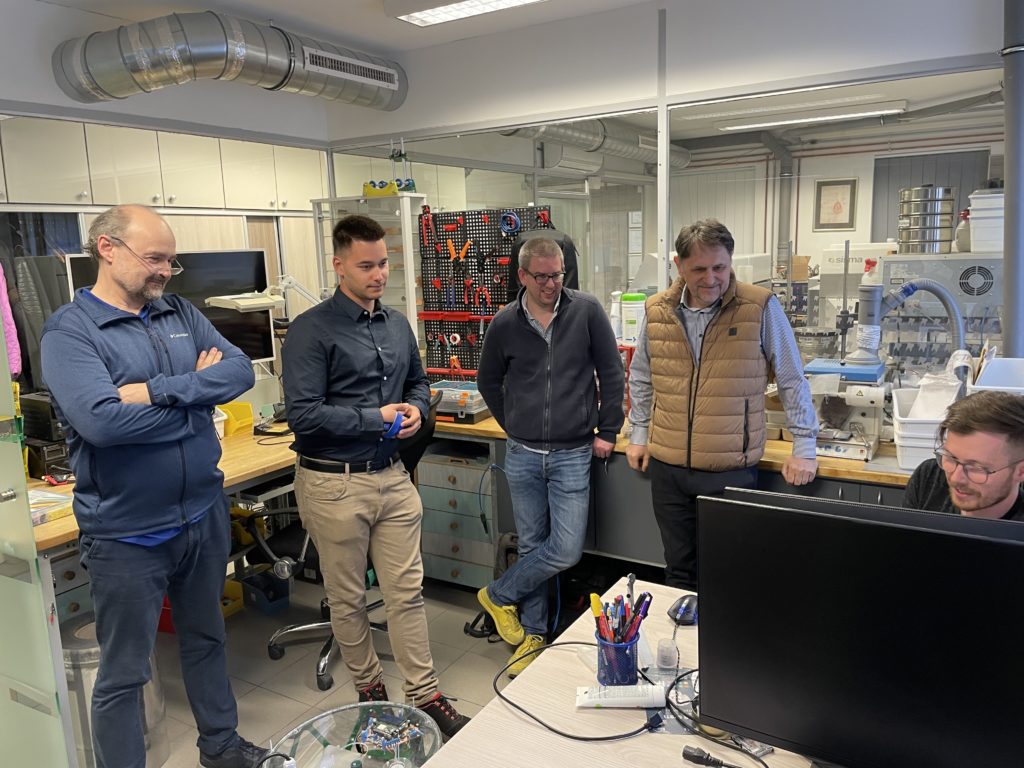Over the next couple of weeks we’ll be running a series of 1:1 interviews with the KTE (Knowledge Transfer Experiment) teams that joined Better Factory through our second open call. These incredible teams are each made up of a SME, artist and technology provider, working together to develop new and personalised products, become cyber-physical systems, and transforming into lean-agile production facilities.
The 3D ART DESIGN project evolves around identifying new applications and markets (such as artistic pens, jewellery, and also large-scale products assembled from separate 3D-prints) for products made from overused powder from medical implants.
Their KTE team includes:
- PREMET (Manufacturing company)
- Studio Nick Ervinck (Artist)
- Lasram Engineering Kft. (Technology Provider)
Let’s get started with the interview!!
Hello, thank you for joining us! To start off, could you tell us why you decided to apply to Better Factory?
SME PREMET: We have participated in several research and development projects before and also found many possibilities to further tweak and optimise in our existing manufacturing processes. Partnering with artists and other industrial partners was just what we needed not only to solve our current technological problems, but also to drag us out of the comfort zone to enter new markets and contribute to innovation.
Artist Studio Nick Ervinck: I have always been fascinated by how art has developed due to new materials and techniques. Somewhat disappointed at contemporary sculpture and it’s lack of renewal, I turned towards architecture, applied sciences and new media, in order to elaborate a new language, and to compose forms and designs that were unthinkable in all those years before. My aim is to let architecture and sculpture meet, and to explore the realm of the impossible by constantly pushing the limits of what we call ‘realistic’.
The studio takes a vanguard position in the field of digital technology (such as 3D technology and computational design methods). 3D printing has the incredible advantage to produce almost any type of intricate geometry or ornament. Moreover, my images balance on the edge of functionality, spatial interventions, digital aesthetics and object-oriented eclecticism. Using copy paste techniques in a 3D software environment, I derive images, shapes and textures from different sources: basilicas, corals, dinosaurs, cottages, Rorschach inkblots, Chinese rocks and trees, manga, twelfth-century floral wallpaper, fauna and flora, anatomical parts,… Simultaneously, my work holds numerous references to the tradition of sculpture, (such as the work of Hans Arp, Henry Moore or Barbara Hepworth) and to architecture (think of Greg Lynn, who introduced the blob as an architectural constructive principle). Consequently, I am particularly interested in how the computer can be used in the realisation of new, organic and experimental (negative) spaces and sculptures within sculptures and how the tension between blobs and boxes is articulated during the digital designing process.
I was then also enthusiastic to see the open call of Better Factory where the collaboration between a production company, software company and an artist is stimulated. An organisation that understands the added value of an artist in a collaboration and research project.
Tech provider Lasram Engineering Kft: We received intelligence through Premet about this opportunity. As a matter of fact, Lasram has participated in numerous European projects already and Better Factory seemed absolutely worthwhile to apply to. We have always pushed ourselves towards the next level of automation in cooperation with Kawasaki robotic arms. Since this opportunity arose, we were eager to design and engineer the forthcoming robotic solution which provides the KTE with an Industry 4.0 solution.

Can you describe the current process for recycling overused titanium powder in the factory?
SME PREMET: Our current core business is manufacturing patient-specific medical implants, so product quality is always our top priority. For these high-end implants, we always use virgin titanium powder, or powder with a very limited number of recycled uses. For medical products that represent lower medical risks – for example we produce dental frameworks from titanium powder – we use titanium powder that has been recycled a few times. But after that, powder recycling becomes problematic for us. That’s why we have to find new opportunities with our partners in Better Factory and try to establish a brand new product portfolio that can be steadily manufactured and uses powder that has been recycled many times previously.
Tech provider Lasram Engineering Kft: During our production process LASRAM also uses Additive Manufacturing and the powder is used several times for certain objects with required material specification based on the level of reuse. In accordance with the powder mixing percentage we design either a robotic gripper or less-functional design element to further improve appearance.
Artist Studio Nick Ervinck: In the past, overused titanium powder had no use as it was not more usable for medical implants that need detail, precision and accuracy. But we can use it for art and design.
How did the idea for the 3DARTDESIGN project come about, and what are some of the initial challenges you have faced?
Tech provider Lasram Engineering Kft: LASRAM needed to design a small footprint solution which involves 3 fully individual processes, namely sand-blasting, acid-etching and anodizing. Therefore the robotic cell is going to work as a multifunctional compact post-processing station. Apart from that, the creation of the additional softwares is the next step to provide a state-of-the-art user-friendly component to achieve better performance with ease.
Artist Studio Nick Ervinck: For me as an artist it was important to find partners that understand the added value of collaborating with an artist – and not just a designer or product designer. With LASRAM and PREMET, I had immediately the feeling that they understood the goal of Better Factory and of the value of collaborating with an artist. We have built several goals: re-use waste powder, colour titanium, ensemble bigger parts, finish, complexity, among others.
“We are planning to produce several types of objects from recycled titanium powder. We are hoping to try both smaller pieces like artistic pens, jewellery, and also large-scale products assembled from separate 3D-prints to unleash Nick’s creative drive and artistic innovation.”
PREMET (SME)
What role does the artist Nick Ervinck play in this project, and how do they collaborate with the rest of the team?
SME PREMET: Nick is an artist full of energy and passion who always pushes the limits of 3D-printing. He has already designed multiple variations of abstract trophies that will be pretty challenging to manufacture. Other than that he will collaborate with us and share ideas on possible colours and surface characteristics that we should achieve when manufacturing his design pieces.
Artist Studio Nick Ervinck: Artist-designed 3D-printed titanium products will be designed by Nick Ervinck, a celebrated Belgian sculptor and contemporary craftsman, famous for his large-scale public art and 3D printing sculpture. His models will ensure personalisation, artistic design and innovative aesthetics. During the design of the models, requirements related to 3D printing and surface treatment will also be taken into consideration. Nick Ervinck will also be involved in the specification of the desired surface finishes, in the determination and development of the surface finish protocols, as well as in the quality control of the produced parts (and of the prototypes).
What specific types of objects are you hoping to produce with the overused titanium powder?
SME PREMET: We are planning to produce several types of objects from recycled titanium powder. We are hoping to try both smaller pieces like artistic pens, jewellery, and also large-scale products assembled from separate 3D-prints to unleash Nick’s creative drive and artistic innovation.
Artist Studio Nick Ervinck: Yes, we’re hoping to produce objects of functional design, artistic design, and art sculpture.
How do you plan to measure the impact of this project in terms of sustainability, economic value, and/or social benefits?
SME PREMET: Making a steady business and solid revenue from ‘waste’ titanium powder would be a good step for us towards circular economy. We can also easily measure the amount of powder we would recycle and the economic value as well. Another aspect here is the creation of automated robotic cells for surface treatment, which may reduce manufacturing time and increase product quality.
Artist Studio Nick Ervinck: We build experience, references, technical solutions, new examples, and we share this through PR and marketing. This will grow the company and the artist towards new opportunities and clients. This is not easy to measure, especially on a short-term basis, because it includes a mix of several factors to grow and gain new sales and commissions.
Tech provider Lasram Engineering Kft: The 3DArtDesign project is designed to be reused just as much as the titanium powder. In fact, LASRAM integrates software components which are not tailored for this very solution but widely usable. The robot platform is also engineered to support a wide-range of robotic arms as well as different processes with the mounted tool-changers. We are devoted to creating a modular solution to fit a great number of customers. Due to its modularity, the sustainability and economic value of this project tends to be higher than the competitors’ serving similar markets.
How do you foresee that this experiment might inform future collaborations between artists and manufacturers?
Artist Studio Nick Ervinck: By now the collaboration has already shown its true colour and seems to be positively fruitful. The possibility to combine ideas which cover not only the manufacturing company’s needs with high-end technological support, but also the vision of an artist is elevating both this project’s reputation and mutual business possibilities for the future.
If you’d like to learn more about 3D ART DESIGN and their experiment, don’t forget you can check out their KTE page here!

